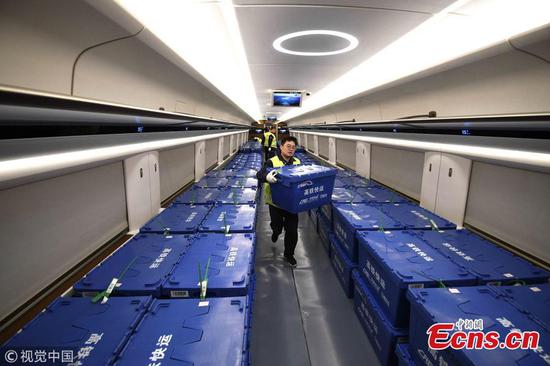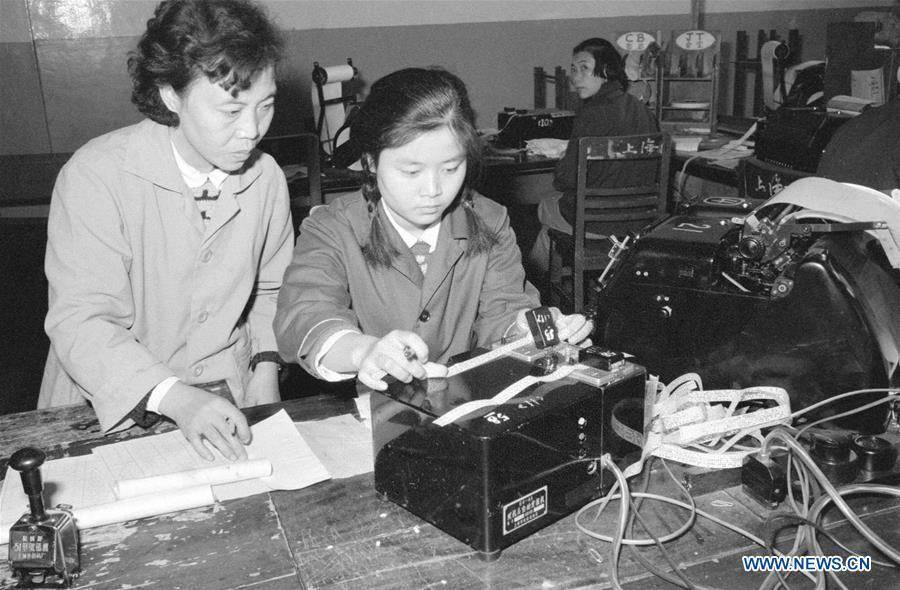
File photo taken in 1979 shows Luo Sufang guiding a new staff to send telegram at Chengdu telecom bureau in Chengdu, southwest China's Sichuan Province. More than four decades of sound economic growth from 1978, the starting year of the reform and opening-up policy, has fundamentally lifted life quality of 1.3 billion Chinese, who are now able to enjoy the "global village" thanks to the advanced telecom infrastructure. However, Chinese people also ever went through the time when writing letters was the most frequent means to contact with faraway relatives, when sending a telegram was the only alternative for an urgent message, when a city's public telephone booths were crammed with homesick people, and when holding a brick-size cellular phone was a symbol of nouveau riche. Times have changed. The improving telecom industry over the past decades has made a radical change in terms of communication means that can never have been imagined. Mobile phone users in China reached 1.42 billion in 2017. The mobile broadband users and those surfing the Internet with cellphones respectively arrived at 1.13 billion and 750 million by the end of 2017, 4.9 times and 1.8 times more than those numbers in 2012. In the following years, China's telecom industry is expected to continue to run parallel with China's rapid development. (Xinhua/Xiong Ruqing)
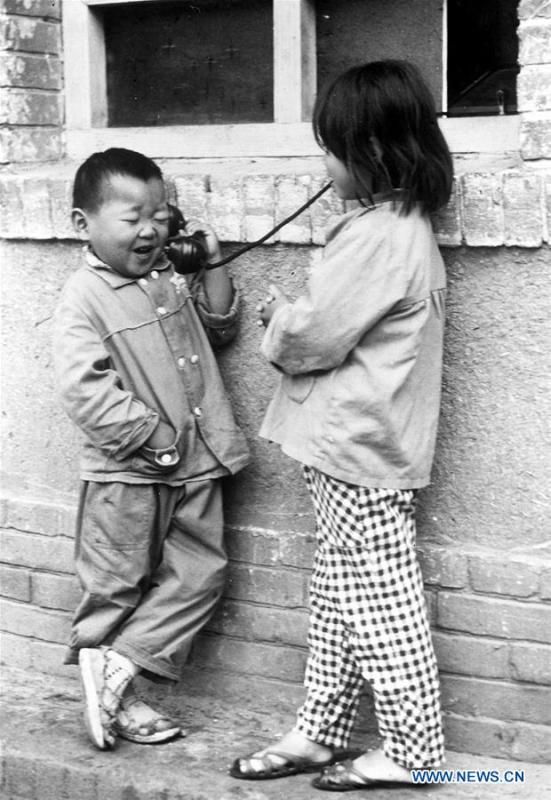
Photo taken on May 10, 1983 shows children making phone call with parents at a public phone booth in central China's Henan Province. More than four decades of sound economic growth from 1978, the starting year of the reform and opening-up policy, has fundamentally lifted life quality of 1.3 billion Chinese, who are now able to enjoy the "global village" thanks to the advanced telecom infrastructure. However, Chinese people also ever went through the time when writing letters was the most frequent means to contact with faraway relatives, when sending a telegram was the only alternative for an urgent message, when a city's public telephone booths were crammed with homesick people, and when holding a brick-size cellular phone was a symbol of nouveau riche. Times have changed. The improving telecom industry over the past decades has made a radical change in terms of communication means that can never have been imagined. Mobile phone users in China reached 1.42 billion in 2017. The mobile broadband users and those surfing the Internet with cellphones respectively arrived at 1.13 billion and 750 million by the end of 2017, 4.9 times and 1.8 times more than those numbers in 2012. In the following years, China's telecom industry is expected to continue to run parallel with China's rapid development. (Xinhua/Lyu Guoxing)
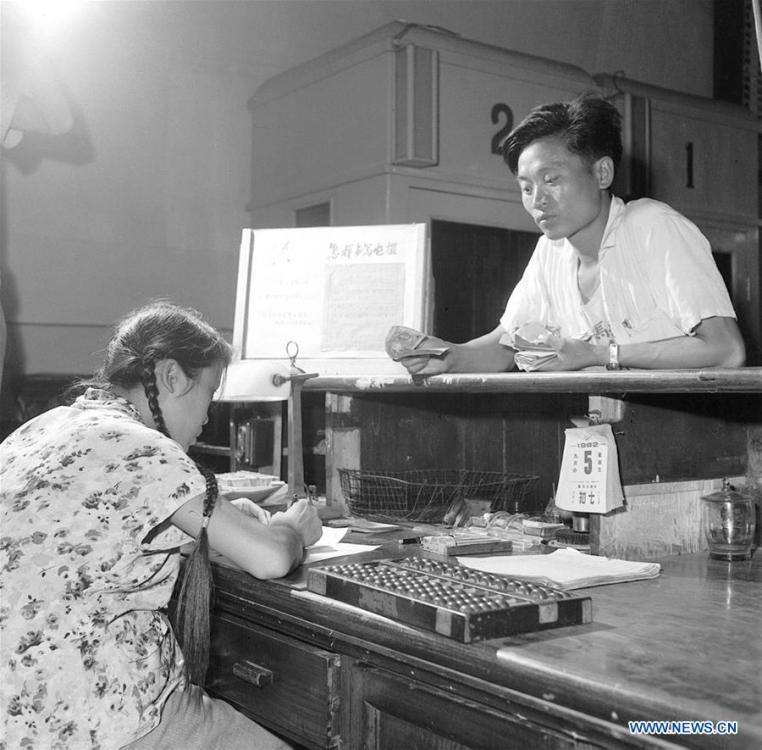
Photo taken on Aug. 30, 1962 shows telegraph operator Li Huiqing (L) helps a man send a telegram at Dongsi telecom bureau in Beijing, capital of China. More than four decades of sound economic growth from 1978, the starting year of the reform and opening-up policy, has fundamentally lifted life quality of 1.3 billion Chinese, who are now able to enjoy the "global village" thanks to the advanced telecom infrastructure. However, Chinese people also ever went through the time when writing letters was the most frequent means to contact with faraway relatives, when sending a telegram was the only alternative for an urgent message, when a city's public telephone booths were crammed with homesick people, and when holding a brick-size cellular phone was a symbol of nouveau riche. Times have changed. The improving telecom industry over the past decades has made a radical change in terms of communication means that can never have been imagined. Mobile phone users in China reached 1.42 billion in 2017. The mobile broadband users and those surfing the Internet with cellphones respectively arrived at 1.13 billion and 750 million by the end of 2017, 4.9 times and 1.8 times more than those numbers in 2012. In the following years, China's telecom industry is expected to continue to run parallel with China's rapid development. (Xinhua)

Postmen ride bikes to send newspapers to subscribers in the suburbs of Tianjin, north China, in March, 1956. More than four decades of sound economic growth from 1978, the starting year of the reform and opening-up policy, has fundamentally lifted life quality of 1.3 billion Chinese, who are now able to enjoy the "global village" thanks to the advanced telecom infrastructure. However, Chinese people also ever went through the time when writing letters was the most frequent means to contact with faraway relatives, when sending a telegram was the only alternative for an urgent message, when a city's public telephone booths were crammed with homesick people, and when holding a brick-size cellular phone was a symbol of nouveau riche. Times have changed. The improving telecom industry over the past decades has made a radical change in terms of communication means that can never have been imagined. Mobile phone users in China reached 1.42 billion in 2017. The mobile broadband users and those surfing the Internet with cellphones respectively arrived at 1.13 billion and 750 million by the end of 2017, 4.9 times and 1.8 times more than those numbers in 2012. In the following years, China's telecom industry is expected to continue to run parallel with China's rapid development. (Xinhua)

File photo taken on Feb. 19, 1959 shows a postman collecting mails from a mailbox in Beijing, capital of China. The postman used a modified bicycle equipped with engine to ride faster, a move made by local authority to accelerate the delivery of letters. More than four decades of sound economic growth from 1978, the starting year of the reform and opening-up policy, has fundamentally lifted life quality of 1.3 billion Chinese, who are now able to enjoy the "global village" thanks to the advanced telecom infrastructure. However, Chinese people also ever went through the time when writing letters was the most frequent means to contact with faraway relatives, when sending a telegram was the only alternative for an urgent message, when a city's public telephone booths were crammed with homesick people, and when holding a brick-size cellular phone was a symbol of nouveau riche. Times have changed. The improving telecom industry over the past decades has made a radical change in terms of communication means that can never have been imagined. Mobile phone users in China reached 1.42 billion in 2017. The mobile broadband users and those surfing the Internet with cellphones respectively arrived at 1.13 billion and 750 million by the end of 2017, 4.9 times and 1.8 times more than those numbers in 2012. In the following years, China's telecom industry is expected to continue to run parallel with China's rapid development. (Xinhua)
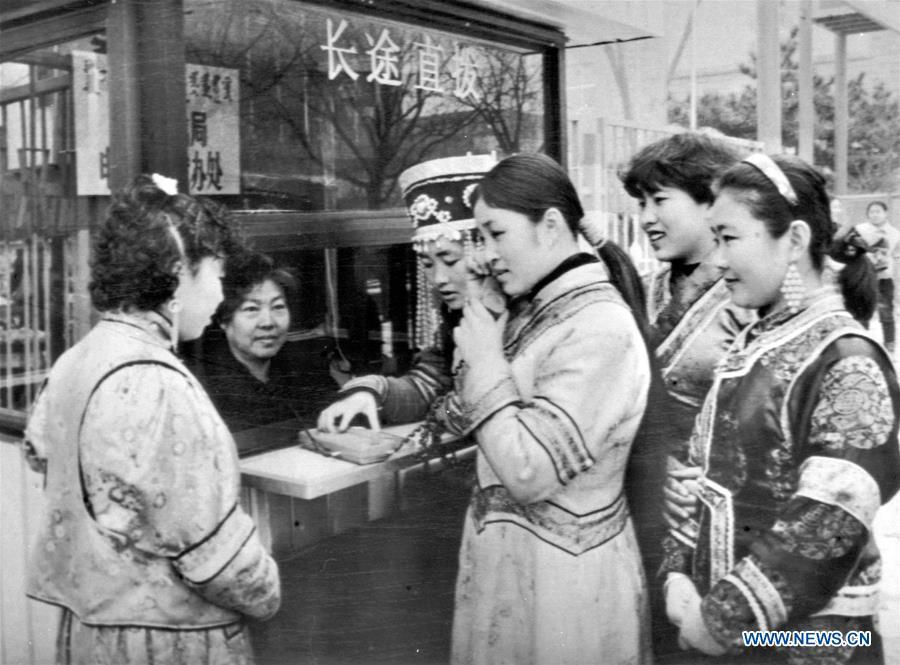
A woman of Mongolia ethnic group makes a long-distance phone call at a public phone booth in Hohhot, north China's Inner Mongolia Autonomous Region, Dec. 7, 1992. More than four decades of sound economic growth from 1978, the starting year of the reform and opening-up policy, has fundamentally lifted life quality of 1.3 billion Chinese, who are now able to enjoy the "global village" thanks to the advanced telecom infrastructure. However, Chinese people also ever went through the time when writing letters was the most frequent means to contact with faraway relatives, when sending a telegram was the only alternative for an urgent message, when a city's public telephone booths were crammed with homesick people, and when holding a brick-size cellular phone was a symbol of nouveau riche. Times have changed. The improving telecom industry over the past decades has made a radical change in terms of communication means that can never have been imagined. Mobile phone users in China reached 1.42 billion in 2017. The mobile broadband users and those surfing the Internet with cellphones respectively arrived at 1.13 billion and 750 million by the end of 2017, 4.9 times and 1.8 times more than those numbers in 2012. In the following years, China's telecom industry is expected to continue to run parallel with China's rapid development. (Xinhua/Yang Shenhe)
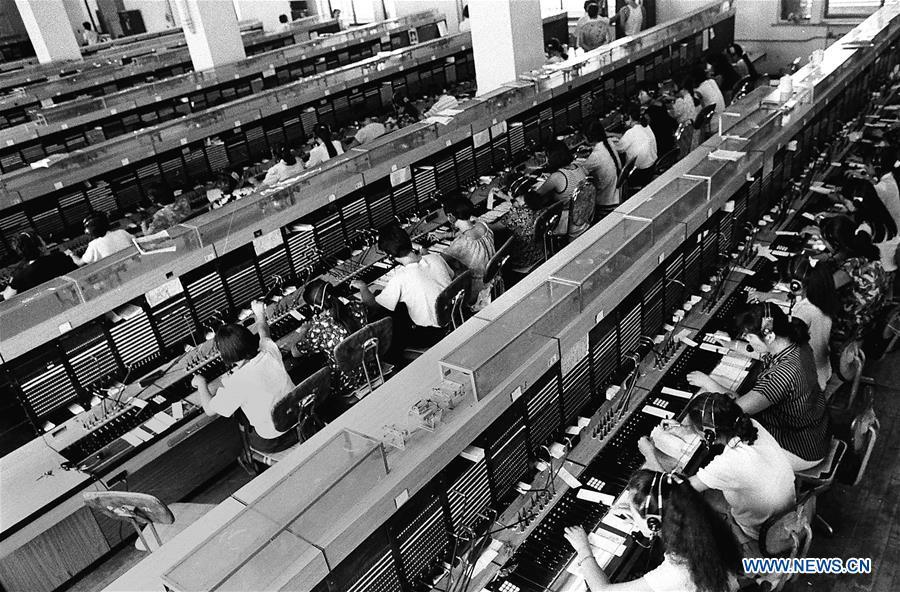
Telephone operators work at Zhengzhou telecom bureau in Zhengzhou, central China's Henan Province, in May of 1986. More than four decades of sound economic growth from 1978, the starting year of the reform and opening-up policy, has fundamentally lifted life quality of 1.3 billion Chinese, who are now able to enjoy the "global village" thanks to the advanced telecom infrastructure. However, Chinese people also ever went through the time when writing letters was the most frequent means to contact with faraway relatives, when sending a telegram was the only alternative for an urgent message, when a city's public telephone booths were crammed with homesick people, and when holding a brick-size cellular phone was a symbol of nouveau riche. Times have changed. The improving telecom industry over the past decades has made a radical change in terms of communication means that can never have been imagined. Mobile phone users in China reached 1.42 billion in 2017. The mobile broadband users and those surfing the Internet with cellphones respectively arrived at 1.13 billion and 750 million by the end of 2017, 4.9 times and 1.8 times more than those numbers in 2012. In the following years, China's telecom industry is expected to continue to run parallel with China's rapid development. (Xinhua/Wang Song)
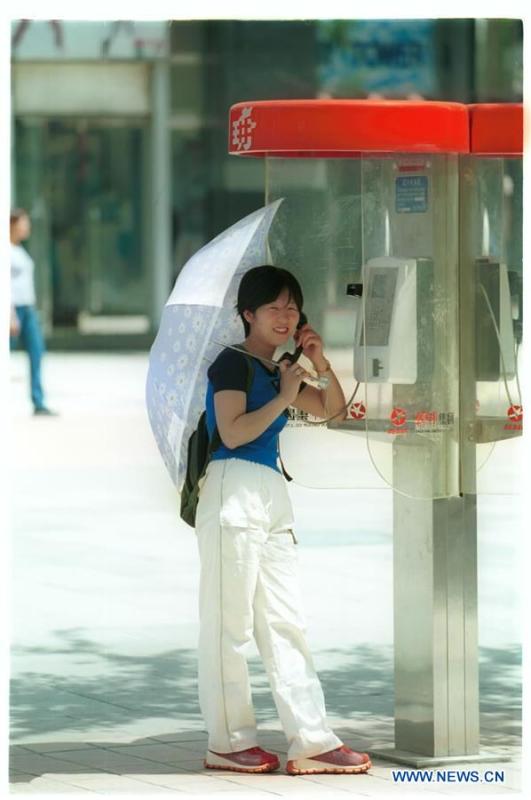
A woman makes a phone call at a phone booth in Beijing, capital of China, May 19, 2001. More than four decades of sound economic growth from 1978, the starting year of the reform and opening-up policy, has fundamentally lifted life quality of 1.3 billion Chinese, who are now able to enjoy the "global village" thanks to the advanced telecom infrastructure. However, Chinese people also ever went through the time when writing letters was the most frequent means to contact with faraway relatives, when sending a telegram was the only alternative for an urgent message, when a city's public telephone booths were crammed with homesick people, and when holding a brick-size cellular phone was a symbol of nouveau riche. Times have changed. The improving telecom industry over the past decades has made a radical change in terms of communication means that can never have been imagined. Mobile phone users in China reached 1.42 billion in 2017. The mobile broadband users and those surfing the Internet with cellphones respectively arrived at 1.13 billion and 750 million by the end of 2017, 4.9 times and 1.8 times more than those numbers in 2012. In the following years, China's telecom industry is expected to continue to run parallel with China's rapid development. (Xinhua/Zhang Xu)
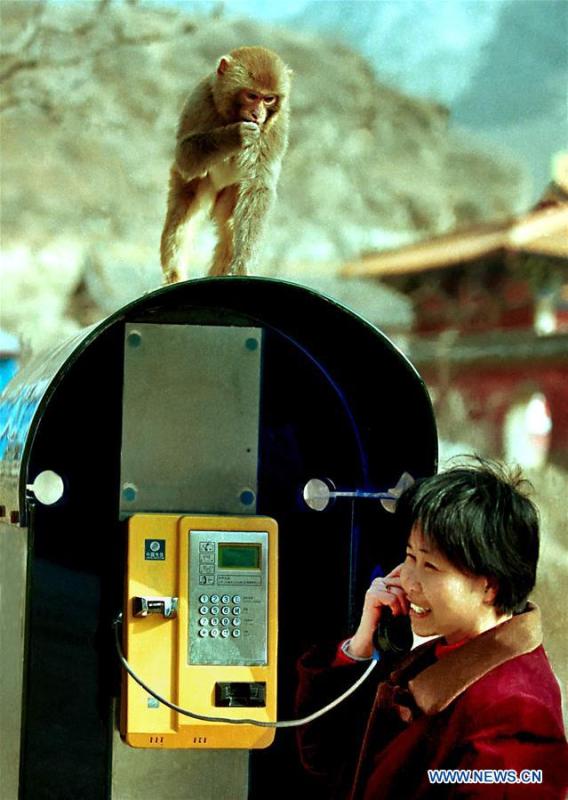
A monkey is seen on top of a booth where a tourist makes a phone call at Wulongkou scenic area in Jiyuan, central China's Henan Province, March 16, 2001. More than four decades of sound economic growth from 1978, the starting year of the reform and opening-up policy, has fundamentally lifted life quality of 1.3 billion Chinese, who are now able to enjoy the "global village" thanks to the advanced telecom infrastructure. However, Chinese people also ever went through the time when writing letters was the most frequent means to contact with faraway relatives, when sending a telegram was the only alternative for an urgent message, when a city's public telephone booths were crammed with homesick people, and when holding a brick-size cellular phone was a symbol of nouveau riche. Times have changed. The improving telecom industry over the past decades has made a radical change in terms of communication means that can never have been imagined. Mobile phone users in China reached 1.42 billion in 2017. The mobile broadband users and those surfing the Internet with cellphones respectively arrived at 1.13 billion and 750 million by the end of 2017, 4.9 times and 1.8 times more than those numbers in 2012. In the following years, China's telecom industry is expected to continue to run parallel with China's rapid development. (Xinhua/Wang Song)
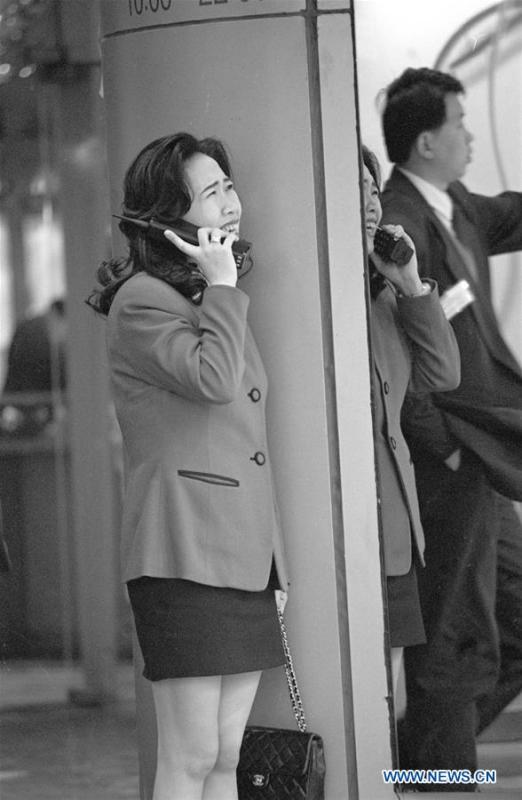
Photo taken in January of 1995 shows a woman using a brick-size cellular phone in Shanghai, east China. Shanghai had about 70,000 users of mobile phone in 1995. More than four decades of sound economic growth from 1978, the starting year of the reform and opening-up policy, has fundamentally lifted life quality of 1.3 billion Chinese, who are now able to enjoy the "global village" thanks to the advanced telecom infrastructure. However, Chinese people also ever went through the time when writing letters was the most frequent means to contact with faraway relatives, when sending a telegram was the only alternative for an urgent message, when a city's public telephone booths were crammed with homesick people, and when holding a brick-size cellular phone was a symbol of nouveau riche. Times have changed. The improving telecom industry over the past decades has made a radical change in terms of communication means that can never have been imagined. Mobile phone users in China reached 1.42 billion in 2017. The mobile broadband users and those surfing the Internet with cellphones respectively arrived at 1.13 billion and 750 million by the end of 2017, 4.9 times and 1.8 times more than those numbers in 2012. In the following years, China's telecom industry is expected to continue to run parallel with China's rapid development. (Xinhua/Zhang Ming)

People make long-distance phone calls at a public booth in Yan'an, northwest China's Shaanxi Province, April 23, 2002. More than four decades of sound economic growth from 1978, the starting year of the reform and opening-up policy, has fundamentally lifted life quality of 1.3 billion Chinese, who are now able to enjoy the "global village" thanks to the advanced telecom infrastructure. However, Chinese people also ever went through the time when writing letters was the most frequent means to contact with faraway relatives, when sending a telegram was the only alternative for an urgent message, when a city's public telephone booths were crammed with homesick people, and when holding a brick-size cellular phone was a symbol of nouveau riche. Times have changed. The improving telecom industry over the past decades has made a radical change in terms of communication means that can never have been imagined. Mobile phone users in China reached 1.42 billion in 2017. The mobile broadband users and those surfing the Internet with cellphones respectively arrived at 1.13 billion and 750 million by the end of 2017, 4.9 times and 1.8 times more than those numbers in 2012. In the following years, China's telecom industry is expected to continue to run parallel with China's rapid development. (Xinhua/Wang Song)

A merchant makes a call with a brick-size cellular phone in Guangzhou, southeast China's Guangdong Province, in January of 1994. More than four decades of sound economic growth from 1978, the starting year of the reform and opening-up policy, has fundamentally lifted life quality of 1.3 billion Chinese, who are now able to enjoy the "global village" thanks to the advanced telecom infrastructure. However, Chinese people also ever went through the time when writing letters was the most frequent means to contact with faraway relatives, when sending a telegram was the only alternative for an urgent message, when a city's public telephone booths were crammed with homesick people, and when holding a brick-size cellular phone was a symbol of nouveau riche. Times have changed. The improving telecom industry over the past decades has made a radical change in terms of communication means that can never have been imagined. Mobile phone users in China reached 1.42 billion in 2017. The mobile broadband users and those surfing the Internet with cellphones respectively arrived at 1.13 billion and 750 million by the end of 2017, 4.9 times and 1.8 times more than those numbers in 2012. In the following years, China's telecom industry is expected to continue to run parallel with China's rapid development. (Xinhua)

Wang Fei, a "professional farmer", receives a call from purchaser at his family farm in central China's Henan Province, Nov. 4, 2014. More than four decades of sound economic growth from 1978, the starting year of the reform and opening-up policy, has fundamentally lifted life quality of 1.3 billion Chinese, who are now able to enjoy the "global village" thanks to the advanced telecom infrastructure. However, Chinese people also ever went through the time when writing letters was the most frequent means to contact with faraway relatives, when sending a telegram was the only alternative for an urgent message, when a city's public telephone booths were crammed with homesick people, and when holding a brick-size cellular phone was a symbol of nouveau riche. Times have changed. The improving telecom industry over the past decades has made a radical change in terms of communication means that can never have been imagined. Mobile phone users in China reached 1.42 billion in 2017. The mobile broadband users and those surfing the Internet with cellphones respectively arrived at 1.13 billion and 750 million by the end of 2017, 4.9 times and 1.8 times more than those numbers in 2012. In the following years, China's telecom industry is expected to continue to run parallel with China's rapid development. (Xinhua/Li An)

Combined photo shows Wang Yin (L upper) talking with his father Wang Yutao (lower) who is in Ecuador for electrical work via video chat system in Changchun, northeast China's Jilin Province, June 18, 2016. More than four decades of sound economic growth from 1978, the starting year of the reform and opening-up policy, has fundamentally lifted life quality of 1.3 billion Chinese, who are now able to enjoy the "global village" thanks to the advanced telecom infrastructure. However, Chinese people also ever went through the time when writing letters was the most frequent means to contact with faraway relatives, when sending a telegram was the only alternative for an urgent message, when a city's public telephone booths were crammed with homesick people, and when holding a brick-size cellular phone was a symbol of nouveau riche. Times have changed. The improving telecom industry over the past decades has made a radical change in terms of communication means that can never have been imagined. Mobile phone users in China reached 1.42 billion in 2017. The mobile broadband users and those surfing the Internet with cellphones respectively arrived at 1.13 billion and 750 million by the end of 2017, 4.9 times and 1.8 times more than those numbers in 2012. In the following years, China's telecom industry is expected to continue to run parallel with China's rapid development. (Xinhua/Lin Hong)

Chen Yu, a Chinese graduate working in Bangkok, talks with his girl friend, who stays in China, via a video call at his home in Bangkok, Thailand, June 12, 2016. More than four decades of sound economic growth from 1978, the starting year of the reform and opening-up policy, has fundamentally lifted life quality of 1.3 billion Chinese, who are now able to enjoy the "global village" thanks to the advanced telecom infrastructure. However, Chinese people also ever went through the time when writing letters was the most frequent means to contact with faraway relatives, when sending a telegram was the only alternative for an urgent message, when a city's public telephone booths were crammed with homesick people, and when holding a brick-size cellular phone was a symbol of nouveau riche. Times have changed. The improving telecom industry over the past decades has made a radical change in terms of communication means that can never have been imagined. Mobile phone users in China reached 1.42 billion in 2017. The mobile broadband users and those surfing the Internet with cellphones respectively arrived at 1.13 billion and 750 million by the end of 2017, 4.9 times and 1.8 times more than those numbers in 2012. In the following years, China's telecom industry is expected to continue to run parallel with China's rapid development. (Xinhua/Li Mangmang)
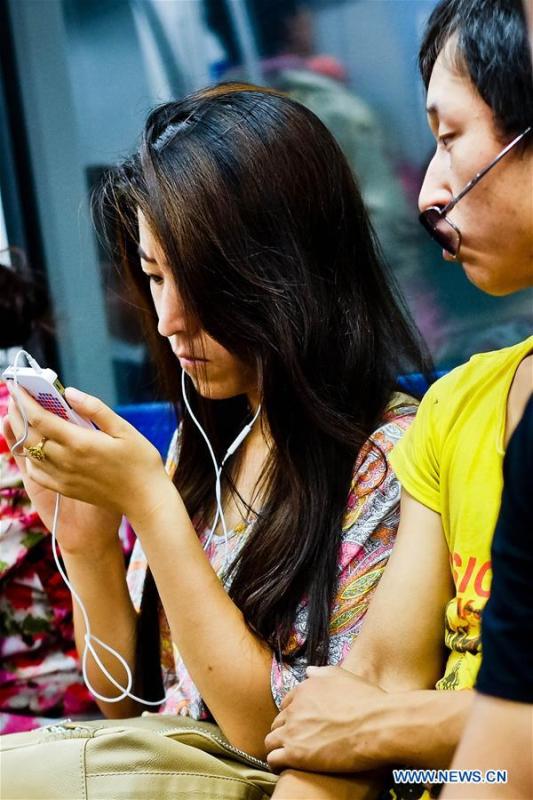
A passenger plays games with the mobile phone on Beijing subway line 2 in Beijing, capital of China, July 18, 2012. More than four decades of sound economic growth from 1978, the starting year of the reform and opening-up policy, has fundamentally lifted life quality of 1.3 billion Chinese, who are now able to enjoy the "global village" thanks to the advanced telecom infrastructure. However, Chinese people also ever went through the time when writing letters was the most frequent means to contact with faraway relatives, when sending a telegram was the only alternative for an urgent message, when a city's public telephone booths were crammed with homesick people, and when holding a brick-size cellular phone was a symbol of nouveau riche. Times have changed. The improving telecom industry over the past decades has made a radical change in terms of communication means that can never have been imagined. Mobile phone users in China reached 1.42 billion in 2017. The mobile broadband users and those surfing the Internet with cellphones respectively arrived at 1.13 billion and 750 million by the end of 2017, 4.9 times and 1.8 times more than those numbers in 2012. In the following years, China's telecom industry is expected to continue to run parallel with China's rapid development. (Xinhua/Zhang Cheng)

A passenger talks with her friend through a phone video call using 4G network on a bullet train from Hefei, east China's Anhui Province, to Jiangshan, east China's Zhejiang Province, Feb. 4, 2015. High-speed railways in Anhui started to offer 4G service to passengers during the Spring Festival travel rush in 2015. More than four decades of sound economic growth from 1978, the starting year of the reform and opening-up policy, has fundamentally lifted life quality of 1.3 billion Chinese, who are now able to enjoy the "global village" thanks to the advanced telecom infrastructure. However, Chinese people also ever went through the time when writing letters was the most frequent means to contact with faraway relatives, when sending a telegram was the only alternative for an urgent message, when a city's public telephone booths were crammed with homesick people, and when holding a brick-size cellular phone was a symbol of nouveau riche. Times have changed. The improving telecom industry over the past decades has made a radical change in terms of communication means that can never have been imagined. Mobile phone users in China reached 1.42 billion in 2017. The mobile broadband users and those surfing the Internet with cellphones respectively arrived at 1.13 billion and 750 million by the end of 2017, 4.9 times and 1.8 times more than those numbers in 2012. In the following years, China's telecom industry is expected to continue to run parallel with China's rapid development. (Xinhua/Du Yu)













